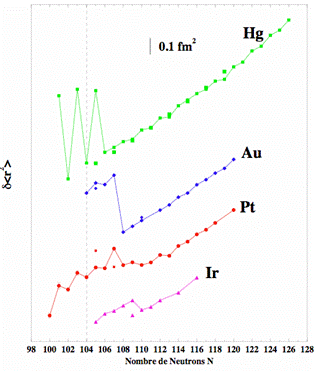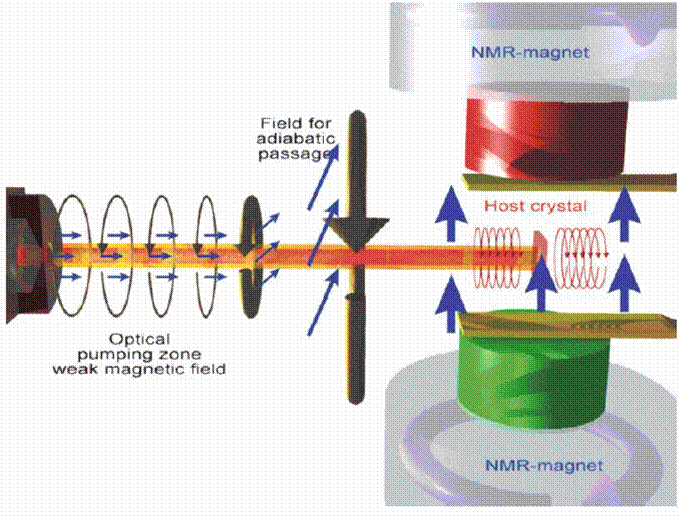Partenaires
LUMIERE
Physics case
Atomic physics and optical techniques have played an important role to study the behaviour of nuclear matter at low excitation energy. Nuclear properties are deduced through the observation of the magnetic and electrostatic hyperfine structure in optical spectra, as well as through the influence of the changes in nuclear charge radii on the isotope shifts between different isotopes of a given element.
For 30 years, lasers were used at accelerators to measure these quantities and the best example is the observation of the sudden change in the nuclear charge radius in the mercury isotopes showing a large shape transition at mid-shell around N=108 (see Fig. 1). Today with different techniques such as collinear laser spectroscopy and ß-NMR applied to optically polarized radioactive beams, laser spectroscopy still continues to deliver key information on properties of nuclear ground states and long-lived isomers with the measurement of the spin, the magnetic moment, the quadrupole moment and the change in the mean square charge radius between two isotopes. These experimental data are highly accurate and the nuclear parameters can be extracted model-independently which constitutes a stringent test for nuclear models.

To study the hyperfine anomaly or to have access to higher order nuclear moments (octupole and hexadecapole) one can use ion traps. Once again, the combination of the laser optical pumping and the radiofrequency scan inside a hyperfine multiplet gives a precision of 10-9 on the magnetic hyperfine constant, allowing to reach the forth order in nuclear deformation.
At SPIRAL2 and its low-energy beam facility DESIR, there is an opportunity of building three kinds of setup to try to cover the whole nuclear chart. A ß-NMR setup will be suitable to study precisely the moments of key cases and, in combination with collinear hyperfine spectroscopy, get unambiguous spin assignments. With a collinear spectroscopy setup, we will have the possibility to study series of isotopes in the intermediate and heavy mass regions. For the heavy elements, a double laser+RF spectroscopy in a Paul trap will be used to study the hyperfine anomaly and higher-order moments up to very high precision.
Description of the setup
The collinear laser spectroscopy is mainly used for its versatility and the high precision that it gives. A laser beam is sent collinearly with an ion or atomic beam of the same size, such that they can resonantly interact. The laser frequency is scanned in order to record the complete hyperfine spectrum from which one can extract the nuclear quantities.
Another issue related to collinear laser spectroscopy is the possibility to polarize the nuclear spins. A high degree of electronic polarization can be achieved by optical pumping with circularly polarized laser light. Via hyperfine coupling, this polarization is transferred to the nucleus and after implantation in a suitable crystal, the magnetic and quadrupole moment of the nucleus can be measured with high precision using a radiofrequency field. The third setup of LUMIERE will be a Paul trap in order to perform microwave double resonance with very few ions. One pumps optically the ions in a state such as one can populate all the Zeeman levels by scanning the radiofrequency. All detected transitions give access to the hyperfine constants and thus to the nuclear parameters. In a Paul trap, the motion amplitude of the ions is large compared to the microwave wavelength so that, at first order, one does not have a Doppler effect, which explains the precision reached.
Possible key experiment
Neutron-rich isotopes in the fission peaks will be available from the SPIRAL2 fission source coupled to a high-resolution mass separator and RFQ, from which low-energy beams are then send into the DESIR setups. Low-energy beams of refractory elements, of proton-rich isotopes and of heavy elements (trans-actinides) will be produced using fusion-evaporation reactions with the very intense stable beams from the SPIRAL2-LINAG. The reaction products will be separated from the primary beam with the S3 super separator spectrometer, stopped in a gas cell and reionized to be sent to the DESIR set-ups. Thus a very wide range of elements and isotopes will be accessible for measurements.
° Collinear spectroscopy:
![]() Charge radius change around 78Ni.
Charge radius change around 78Ni.
![]() Charge radius change in Rb, Sr an Y.
Charge radius change in Rb, Sr an Y.
![]() Hyperfine structure and charge radii of trans-actinides
Hyperfine structure and charge radii of trans-actinides
° ß-NMR:
![]() Ground state spin in N=49 and N=51 isotones with even Z
Ground state spin in N=49 and N=51 isotones with even Z
° Microwave double resonance in Paul trap (with S3 beams):
![]() Charge radius of 100Sn
Charge radius of 100Sn
![]() Quadrupole moments in the transfermium isotopes
Quadrupole moments in the transfermium isotopes

Fig. 2: Schematic view of a beta-NMR setup.